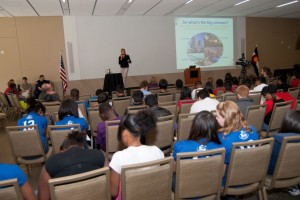it may be cold outside…
But it’s warm at these Affiliates! While you’re on winter break, check out the Smithsonian in your neighborhood:
The Smithsonian Community Coral Reef is on view at the Putnam Museum in Davenport, Iowa. The coral reef, composed of thousands of crocheted natural forms, creates a version of the Great Barrier Reef with loopy “kelps,” fringed “anemones,” crenellated “sea slugs,” and curlicue “corals.” On loan from the National Museum of Natural History.

Photo credit: Putnam Museum
Imagine you too are standing on a sun-dappled lawn picking wildflowers just like the figure in Dear Fay, one of several painted ceramic sculptures on loan to the Springfield Museum of Art in Springfield, Ohio, for their exhibition Jack Earl: A Modern Master- A Retrospective. On loan from the Smithsonian American Art Museum, through January 6, 2013.

Photo credit: Smithsonian American Art Museum
Native Words, Native Warriors tells the remarkable story of Indian soldiers from more than a dozen tribes who used their Native languages in the service of the U.S. military. On view at the Heard Museum in Phoenix, Arizona, through March 2013. Organized for travel by the Smithsonian Traveling Exhibition Service.

Courtesy U.S. Marine Corps
Sick of dreary white, winter days? Head to the Polk Museum of Art in Lakeland, Florida, for Vibrant Color: Vintage Celebrity Portraits from the Harry Warnecke Studio, a collection of color photographs of celebrities who rose to fame at a time when color photography was in its infancy. Organized by the National Portrait Gallery, the exhibition is on view until January 12, 2013.

Photo credit: Harry Warnecke Studio for The Daily News/National Portrait Gallery
While you’re in Florida, stop by the Frost Art Museum in Miami. On view until January 13, 2013 is Reflections Across Time: Seminole Portraits, a collaboration with fellow Affiliate Ah-Tah-Thi-Ki Museum in Clewiston, Florida. Showing more than 150 years of portraits of Seminole leaders and tribal members, the exhibition features works of art from the National Museum of the American Indian, National Portrait Gallery and the Smithsonian American Art Museum.

Photo credit: Frost Art Museum
In 1898, New York photographer Gertrude Käsebier watched the grand parade of Buffalo Bill’s Wild West show, on its way to Madison Square Garden. Inspired by what she saw, she photographed the Lakota (Sioux) travelling with the show in her 5th Ave studio. The result was a set of prints that are among the most compelling of Käsebier’s celebrated body of work. See Buffalo Bill’s Wild West Warriors: Photographs by Gertrude Käsebier at the Northwest Museum of Arts and Culture in Spokane, Washington, through February 9, 2013. On loan from the National Museum of American History and includes artifacts from fellow Affiliate, Buffalo Bill Historical Center in Cody, Wyoming.

Photo credit: Dean Davis Photography
Mittens, boots, puffy jacket and scarf may work in our winter weather, but imagine what astronauts had to prepare for when venturing into space! Suited for Space, an exhibition from the Smithsonian Traveling Exhibition Service and the National Air and Space Museum, explores the evolution of spacesuit development from the first quarter of the 20th century until the dawn of the shuttle era. On view at the American Textile History Museum in Lowell, Massachusetts, until March 3, 2013.

Phot credit:Sun/Bob Whitaker
Is the Smithsonian in YOUR neighborhood? Find an Affiliate here.
















